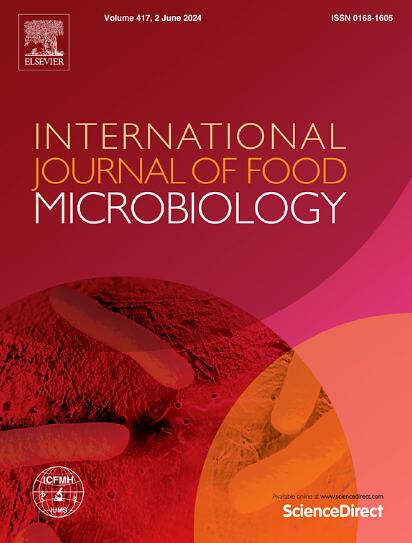Impact of intrinsic factors and storage temperature on Escherichia coli O157:H7, Salmonella enterica subsp. enterica and Listeria monocytogenes survival in fruit juices
IF 5
1区 农林科学
Q1 FOOD SCIENCE & TECHNOLOGY
International journal of food microbiology
Pub Date : 2025-02-10
DOI:10.1016/j.ijfoodmicro.2025.111109
引用次数: 0
Abstract
There is a strong trend among consumers to prefer increasingly less processed fruit juices. This raises concerns in terms of food safety, as these products may not always be free from pathogen contamination. While the low pH and the presence of antimicrobial compounds in these juices are generally considered inhibitory to pathogens, there have been occasional reports of foodborne outbreaks associated with fruit juices. However, it is important to note that the frequency of outbreaks linked to fruit juices remains significantly lower compared to other fresh produce, reflecting both the inherent properties of juices and differences in consumption patterns. The present study evaluated the survival of three different pathogens (Escherichia coli O157:H7, Salmonella enterica subsp. enterica, and Listeria monocytogenes) in persimmon, apple, peach, orange, strawberry, and red grape juices stored at 4, 15, and 25 °C, aiming to establish relationships between the food matrix and pathogen survival. Red grape and strawberry juices exhibited a sharp decline in S. enterica and L. monocytogenes populations. Conversely, orange juice was the most conducive to pathogen survival. Based on the Weibull model, L. monocytogenes exhibited δ values ≤ 0.581 ± 0.173 days in strawberry juice, while in red grape juice, the population was below 1 log10 CFU/mL after inoculation. Regarding Salmonella strains, the δ values were <0.376 ± 0.244 days in strawberry juice and <0.895 ± 0.177 days in red grape juice. Of great concern is the serotype of E. coli O157:H7, as it demonstrated the highest survival trends in all fruit juices samples with the highest δ values in most cases. For instance, after 9 days, it maintained levels above 1.6 log10 CFU/mL in most juices stored at 4 °C (initial populations ranged from 4.8 ± 0.1 to 5.0 ± 0.1 log10 CFU/mL). In most of the analysis, physicochemical parameters, except the pH, exhibited negative correlations between pathogen populations. But in comparison, the correlations between the content of a specific polyphenol and bacterial populations were higher. For instance, after the inoculation, quercetin, kaempferol and epicatechin content presented the highest negative correlation against S. Enteritidis and both L. monocytogenes strains (between −0.936 and −0.946). The interesting finding is the strong negative correlation between the kaempferol content and all bacterial populations, not only after inoculation but also after 2 days at the three temperatures evaluated (the highest value was −0.961 against L. monocytogenes CECT 4032 at 25 °C). Pathogen levels after 2 days at 4 °C raise significant food safety concerns, given that these are typical conditions for untreated juices. Additionally, the consistent presence of E. coli O157:H7 in all juice samples throughout storage poses a significant food safety risk, as it is a leading cause of foodborne outbreaks associated with juices.
内在因素和贮藏温度对大肠杆菌O157:H7、肠炎沙门氏菌亚群的影响。肠道菌和单核增生李斯特菌在果汁中的存活
在消费者中,有一种强烈的趋势,即越来越喜欢加工程度较低的果汁。这引起了人们对食品安全的关注,因为这些产品可能并不总是没有病原体污染。虽然这些果汁的低pH值和抗菌化合物的存在通常被认为对病原体有抑制作用,但偶尔也有与果汁有关的食源性疾病爆发的报道。然而,值得注意的是,与其他新鲜农产品相比,与果汁有关的暴发频率仍然明显较低,这既反映了果汁的固有特性,也反映了消费模式的差异。本研究评估了三种不同病原菌(大肠杆菌O157:H7,肠沙门氏菌亚种。柿子、苹果、桃子、橘子、草莓和红葡萄汁在4、15和25°C下储存,旨在建立食物基质与病原体存活之间的关系。红葡萄汁和草莓汁中肠链球菌和单核增生乳杆菌的数量急剧下降。相反,橙汁最有利于病原菌的存活。根据Weibull模型,单增李斯特菌在草莓汁中的δ值≤0.581±0.173 d,在红葡萄汁中的δ值低于1 log10 CFU/mL。沙门氏菌在草莓汁中的δ值为0.376±0.244 d,在红葡萄汁中的δ值为0.895±0.177 d。值得高度关注的是大肠杆菌O157:H7的血清型,因为它在大多数情况下δ值最高的所有果汁样本中显示出最高的存活趋势。例如,9天后,在大多数4°C储存的果汁中,它的水平保持在1.6 log10 CFU/mL以上(初始种群范围为4.8±0.1至5.0±0.1 log10 CFU/mL)。在大多数分析中,除pH值外,理化参数与病原菌群体呈负相关。但相比之下,特定多酚含量与细菌数量之间的相关性更高。接种后槲皮素、山奈酚和表儿茶素含量与肠炎链球菌和两株单核增生乳杆菌的负相关最高(- 0.936 ~ - 0.946)。有趣的发现是山奈酚含量与所有细菌种群之间存在很强的负相关关系,不仅在接种后,而且在三种评估温度下2天后也存在这种关系(25°C时,山奈酚含量对L. monocytogenes CECT 4032的最大值为- 0.961)。考虑到这些是未经处理的果汁的典型条件,在4°C下放置2天后的病原体水平引起了重大的食品安全问题。此外,在整个储存过程中,所有果汁样品中始终存在大肠杆菌O157:H7,这构成了重大的食品安全风险,因为它是与果汁有关的食源性疾病暴发的主要原因。
本文章由计算机程序翻译,如有差异,请以英文原文为准。
求助全文
约1分钟内获得全文
求助全文
来源期刊
CiteScore
10.40
自引率
5.60%
发文量
322
审稿时长
65 days
期刊介绍:
The International Journal of Food Microbiology publishes papers dealing with all aspects of food microbiology. Articles must present information that is novel, has high impact and interest, and is of high scientific quality. They should provide scientific or technological advancement in the specific field of interest of the journal and enhance its strong international reputation. Preliminary or confirmatory results as well as contributions not strictly related to food microbiology will not be considered for publication.

 求助内容:
求助内容: 应助结果提醒方式:
应助结果提醒方式:


